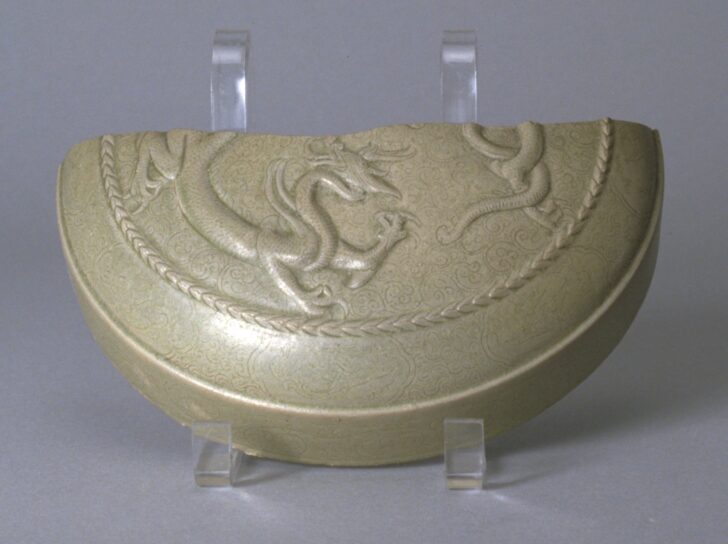Fragment of box lid
Chinese

Description
Copies and Invention in East Asia (August 17, 2019 - January 5, 2020)
Among many new materials that Seifū Yohei III invented was a white porcelain clay he called Taihaku-ji (meaning “great white porcelain”). To create Taihaku-ji, he researched Chinese Dehua ware produced during the Ming dynasty (1368 – 1644), which was known for its thin body and milky-color glaze (4). Because of the high plasticity of the clay, Dehua ware was often used for religious sculptures and vessels with delicate low-relief decorations. He also studied the relief and incising techniques of elegant wares from imperial kilns of the Song dynasty (960–1279) (5). The small teapot and pitcher (2) are for sencha, the Chinesestyle tea ceremony in vogue among Japanese literati (artists who embraced the Chinese amateur-scholar artist tradition) in the nineteenth century. Yohei himself was a part of the literati circle in Kyoto, and accomplished at painting, calligraphy, and poetry. Knowing the taste of literati contributed to his great popularity among the intellectuals of the day.
Round ceramic boxes with slightly domed lids and a pale olive-gray glaze, such as that seen here, are examples of Yue ware (Yueyao) produced in China's southeast Zhejiang province in the 10th century. The delicate color of the glaze was so highly prized that it was called "mise," or "secret color." Smaller versions of such boxes were made for ladies' cosmetics, but both the dragon theme and the large size of this lid suggest that the box was designed for a man's use. Despite the fragmentary condition of this box lid, it is one of the finest examples of Chinese ceramics in the Museum's collection.
Subject Matter:
Round ceramic boxes with slightly domed lids and a pale olive-gray glaze, such as that seen here, are examples of Yue ware (Yueyao) produced in China's southeast Zhejiang province in the 10th century. The delicate color of the glaze was so highly prized that it was called "mise," or "secret color." Smaller versions of such boxes were made for ladies' cosmetics, but both the dragon theme and the large size of this lid suggest that the box was designed for a man's use. Despite the fragmentary condition of this box lid, it is one of the finest examples of Chinese ceramics in the Museum's collection.
Physical Description:
This fragment of a “Secret Color” Yue stoneware (秘色越瑶) box lid has straight sides with a shoulder curving to a flat top. The lid has a finely detailed dragon in relief inside a twisted rope roundel border against a ground of finely incised floral meander, covered in a sea-green glaze.
Usage Rights:
If you are interested in using an image for a publication, please visit https://umma.umich.edu/request-image/ for more information and to fill out the online Image Rights and Reproductions Request Form.